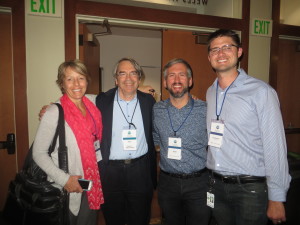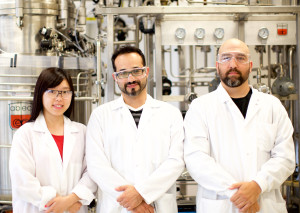Berkeley Lab teams aced the summer session of the Bay Area Regional NSF Innovation Corps (I-Corps™), a program educating researchers and entrepreneurs in pathways to reach people and industries in need of innovation. Based on popular vote across all participants, the Sepion team – Peter Frischmann, Brett Helms, and Michel Fouré – received the People’s Choice Award for the best all-around team.
“My experience in I-Corps was transformational, and the journey continues!” said Peter Frischmann.
The FutureBio team – Katy Christiansen, Nathan Hillson, Vivek Mutalik, and industry mentor Kinkead Reiling – earned the Trailblazer Award. With the training program behind them, Sepion, FutureBio, and a third Berkeley Lab team, MvT-Omics (Ling Liang, Hector Garcia Martin, and Garrett Birkel), are ready to advance their technology solutions to the next step.

FutureBio Team L-to-R: Vivek Mutalik, Kinkead Reiling, Nathan Hillson, Katy Christiansen
Collaborative Efforts
Working in partnership, André Marquis, Executive Director, Lester Center for Entrepreneurship and Innovation, Haas School of Business, and Elsie Quaite-Randall, Chief Technology Transfer Officer with the Lab’s Innovation and Partnerships Office (IPO), facilitated I-Corps participation for all three teams with funding from the Directorate, JBEI, the Energy Sciences Area, the Materials Sciences Division, and the Molecular Foundry.
“IPO has taken the lead on programs such as I-Corps and Lab-Corps, DOE’s pilot program based on the I-Corps model, to support researchers’ lab-to-market efforts and grow the Lab’s innovation ecosystem,” said Quaite-Randall.
Robin Johnston, Deputy Chief Technology Transfer Officer and the Lab-Corps PI, described the value of I-Corps and Lab-Corps for Berkeley Lab researchers.
“To be an innovator requires the ability to adapt to circumstances that may be beyond one’s control, and that requires the capacity to understand the changing environment,” said Johnston. “The I-Corps and Lab-Corps customer discovery process develops these abilities in researchers interested in starting a company – entrepreneurs – and those interested in advancing technology within Berkeley Lab – intrapreneurs.”
From IPO to I-Corps
In advance of the six-week program, hosted at the Haas School of Business, IPO staff helped the teams identify potential customer segments and value propositions that would form the core of their initial business model canvas, an analytical tool for entrepreneurs. IPO also provided guidance to teams on how to conduct and analyze customer interviews.
Even team members with little business experience quickly internalized and applied the scientific process of forming a business hypothesis, testing it, revising it, and testing it again. Along the way, they also strengthened skills applicable both inside and outside the lab setting.
“The lessons of I-Corps highlight the critical role customer feedback can play in program building at Berkeley Lab,” said Brett Helms of the Sepion team. “I will never write a grant the way I did before I-Corps.”
Added Russell Carrington, IPO Technology Commercialization Associate, “Team members who were not communicating the value of their technologies in our first meetings morphed into compelling presenters – persuasive and passionate.”
Boot Camp and Beyond
The six-week I-Corps program starts and ends with boot camp sessions in which industry experts and seasoned entrepreneurs ask pointed questions about potential markets. The advisors help each team hone a realistic, informed commercialization plan and avoid mistakes – from making a product that no one wants, to focusing on a market that is too heterogeneous.
During the weeks between boot camps, each team sought up to 100 customers to interview to better understand customers’ needs and then clearly define its business value proposition. At the final boot camp, teams reported whether they were a “Go,” meaning work would continue on the new enterprise, or a “No Go.” All three Berkeley Lab teams announced they were a “Go” and prepared short videos summarizing their findings and I-Corps experience:
Future Markets
Sepion is investigating funding options for a potential startup based on its membrane platform to extend battery life and reduce costs for more reliable electrochemical energy storage. MvT-Omics discovered a bigger market in the biotech, pharma, and human health fields for its Google Maps-like tool, used to visualize and explore metabolism data, than in biofuel and biochemical production optimization as originally positioned. The team has already planned next steps to license their technology.
“Our technology is ahead of the curve and we have the first mover opportunity. We are passionate about the new market,” said Ling Liang.
FutureBio is moving forward with a collaborative biological engineering foundry supplying foundational tools, data, and expertise to advance low input agriculture, sustainable production of fuels and chemicals, and cures for disease. Unlike technology teams with a for-profit startup goal, FutureBio participated in the I-Corps program to understand how a non-profit research institute could contribute to the biotech industry’s needs and to develop clear partnership models to present to companies seeking bioengineering resources as well as to government funding program managers.
Innovation Ecosystem
IPO staff used feedback from the experience to build on its entrepreneurial and intrapreneurial educational resources for future teams participating in I-Corps and Lab-Corps. Looking longer term, IPO believes researchers who complete the training will share what they learn and help grow the Lab’s innovation ecosystem.
“We hope that in addition to supporting individual researchers and technologies, these programs will enable the Lab as a whole to grow and adapt to a changing funding environment,” said Robin Johnston.
Following are short videos from all teams participating in the Bay Area Regional NSF I-Corps™ summer session.
# # #

